Dissecting Operations in Spatial Compositions through Acoulogy as Sonic Thinking
2024
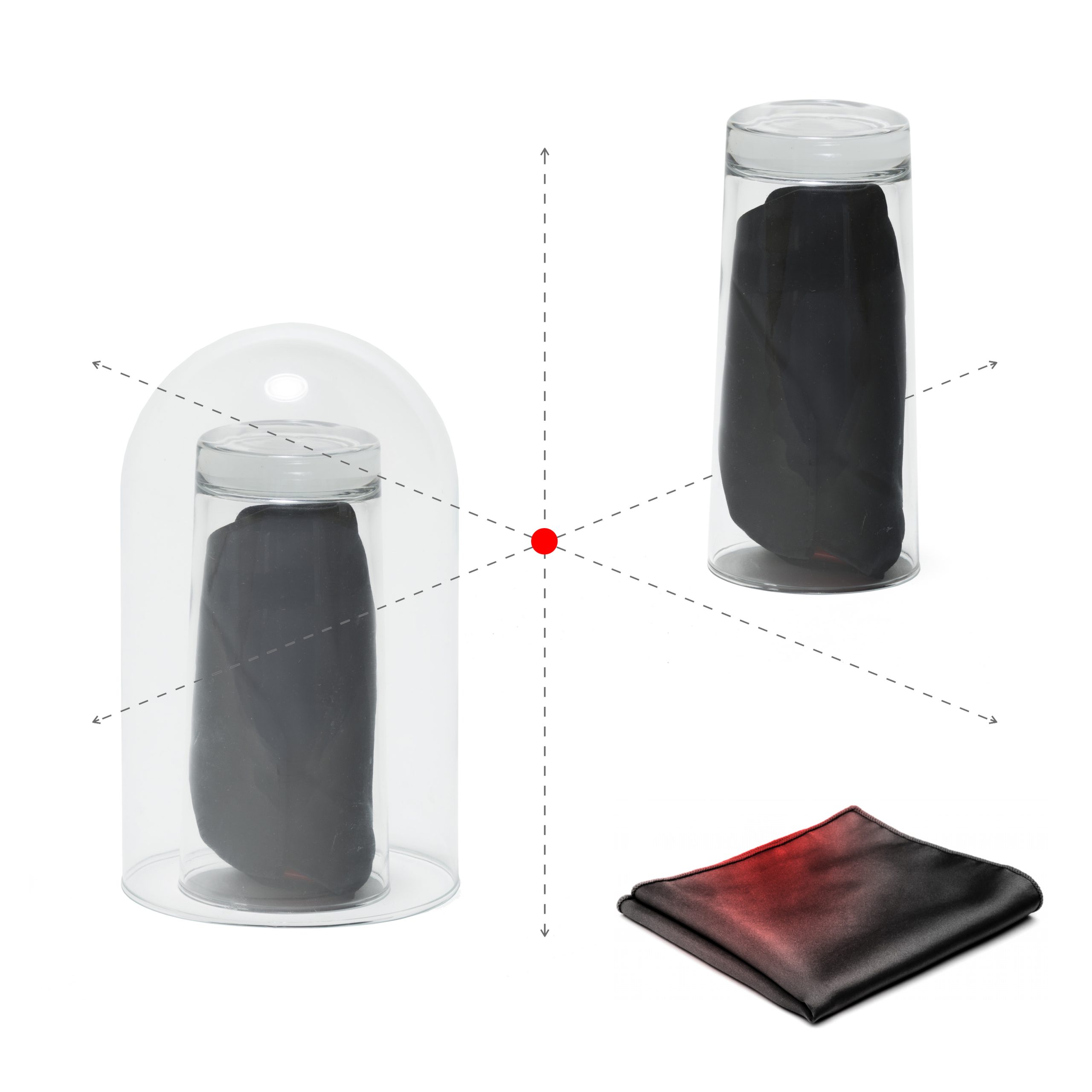
Abstract
Between 2009–2023 Coppice, a collaboration between Noé Cuéllar and Joseph Kramer, has produced various works of experimental music whose compositional processes negotiate multiple modes of presentation, live and fixed (or recorded), at the intersection where sound is technologically transformed and variably perceived.
Retrospecting through a selective chronology of works, recurring and overarching themes are identified: the strategization of objectifying sound, and its aestheticization. These themes are driven by a desire to make perceptible various spatialities of sound, and cause shifts in listening vantage points to alter their perception as part of a multi-sided musical object.
Coppice’s interests in objectifying sound, casting spaces, and traversing music as if cross-sectioning an object or space are contextualized in light of film and sound theorist and experimental musician Michel Chion’s acoulogy, particularly its considerations of the technological transformation of sound, the difficulties in treating sound like an object, and sonic framing. Driven by investigation, Coppice’s self-reflexive art and study resonate with sonic thinking, what writer Bernd Herzogenrath proposes as a philosophical inquiry into music as a form of thinking in correspondence with artistic research as a media-philosophical practice.
Involved with arguments brought forth in acoulogy and sonic thinking, Coppice’s music is not the arguments themselves, but artistic abstractions that share inquiries into and from within the auditory dimension. Artistically entangled in their discourse, this study explores how Coppice works embed materials, sound, media, varieties of spaces, and their reflexive ambiguities, in listening encounters that themselves are part of a continual experimental music process.
Introduction
Coppice is an artistic partnership we co-founded in Chicago in 2009. Operating in cycles that study particular instrumental constraints (bellows and electronics between 2009-2014, physical modeling and modular between 2024-2018, and a range of capture-reproduction media between 2018-2022), each study has evolved from impromptus to elaborate compositions for live settings. An important part of its compositional processes, and of focus in this writing, is the negotiation of ideas for live (concerts and performed installations) and fixed (or recorded) contexts, two distinct modes of presentation in mutual compositional relation.
Such negotiations address how instrumentation is presented, in space, and from which perspectives it is amplified and captured, creating yet more spaces. Made up of acoustic instruments and electronic devices, Coppice’s earlier instrumentation was altered through preparation and modification techniques, to bring out unique sonic characteristics individually, and in mutual dependence when in duo juxtaposition. Those sonic identities come into greater focus through recording, amplification, and mixing strategies that are not merely documentary but in themselves compositional. Microphone techniques, electroacoustic effects, diffusion using multichannel sound systems (which may be of custom design), among other techniques are part of Coppice’s accretionary compositional processes that stem from instrumental constraints.
Coppice’s compositional processes is not a set of procedures as much as a dynamic set of relations between the preparation, modification, or design of instruments and devices, the development of duo performance techniques, the devising of technologies and audio production of mixed fidelities, and considerations of audience and spatial contexts. Observing a span of fourteen years of projects, this writing identifies Coppice’s tendencies to experiment with how listening perception is an active part of that compositional dynamic, at the intersection of different kinds of spaces that are not only physical.
While the confirmation of musical effects on experience may be highly subjective, corroborations by listeners that have written about Coppice’s music are presented ahead, and reinforced by further references to perceptual effects that this music may transpire. To elucidate on these, terminology of sonic effects by philosopher and musicologist Jean-François Augoyard and sociologist and urban planner Henry Torgue, among others including Coppice’s own, are referenced throughout this document.¹
This document is a result of Coppice’s body of work having evolved overarching patterns of musical experimentation and artistic research since 2009. These reveal a sustained interest in addressing sound’s crossing of domains (acoustic, electronic, imaginary) and dilemmas of sounds’ objectification. Also of interest are forms of addressing a listener’s auditory experience as part of, and not external to, its experimental compositional framework. These interests are enmeshed with materialities, ephemeralities, technological processes, and ongoing invitations for a listener to consider their position amid various configurations.
The work of film and sound theorist and experimental musician Michel Chion, most particularly his acoulogical treatise, is key in understanding Coppice’s experimentation with sonic spatiality, objectness, and perception. Chion’s revival of the term acoulogy stands for a becoming science “of what one hears considered from every angle,”² as an extension of its original proposed meaning by composer Pierre Schaeffer, “the study of the mechanisms of listening and of the properties of sound objects with respect to their potential for music within the perceptual field of the ear,”³ whose ideal is a “reunion [with the] “most overarching music possible.”⁴
Chion’s acoulogical treatise has directly informed our identification of recurring concerns in Coppice works between 2009–2023, particularly in how sound is transformed by technologies (and how those transformations are perceived), and questions of whether sound can be treated like an object (and if so how, leading up to a direct investigation of sonic framing). These postphenomenological relations between sound technologies and perception in turn point to how Coppice imagines music acoulogically over time.
In his acoulogical treatise, the 2016 book Sound, Chion presents ten difficulties in treating sound like an object, the sixth of which is most notable in Coppice works as exemplified ahead in this document: “[b]ecause sound is hard to isolate in time and in space—in the perceptual continuum,”⁵ continuing:
With sounds, the identification of cohesive units is difficult. Many sonic events link up, mask each other, or overlap in time and space in such a way that carving them out perceptually in order to study them separately, collectively, or in combinations of elements is difficult.⁶
Chion breaks down this difficulty into two sub-difficulties, first of temporal segmentation:
[in] arts that make use of sound editing— there is no equivalent for the notion of the [cinematic] shot, that is, the principle of a cohesive unit that is easy to spot in “all-or-nothing” terms (and which is identified, in the case of animated films, as what is perceived between two breaks in visual continuity) […] For sound, we have no such unit of the sort […] In other words, the units for dividing up the sonic flux are relative to each listening system (musical, linguistic, and so on) and to its levels of articulation. These units cannot be transposed from one to the others.⁷
and of spatial isolation:
[There is the difficulty] of isolating in space a sound that one would like to study in relation to others that exist at the same time. It is impossible for us to “zoom in” on a sound when others resonate simultaneously with a similar force. […] [T]here is no sonic frame for sounds.⁸
These difficulties of sounds’ temporal segmentation and spatial isolation, and a lack of sonic framing, are direct subject matter in several Coppice works. Its compositional framework, which follows aesthetic, technical, and perceptual considerations, experiments with how treating sound like an object may be represented in and as abstract music, and recognized, in turn, through an experimental listening that may be, ideally, acoulogically-engaged.
As a consequence of these explorations for over ten years, Coppice’s most recent works convolute the question of sonic objectification into one of creative self-reflexivity in a logic of mediation perhaps most common in visual than auditory cultures. As an artistic and not a scientific or academic proposal, Coppice’s self-reflexivity expresses its own sonic thinking, and this document is proposed to guide approaches toward those works and thinking through them. Thus this document is also an annex to Coppice’s retrospective audio paper Stewardship to Obsolescence and Preservation: Listening to Specimen Music through Yerkes Observatory’s Refractor and Reflector Telescopes (2021),⁹ which poeticizes these concerns and questions within a speculative sonic frame.
The dilemmas of sonic objectification and framing, among others, continually recur as philosophical dilemmas and paradoxical inquiries reflexive of the auditory dimension, not dissimilar to those that experimental music may pose as perceptual provocations to a listener. In Chion’s words, “[t]hat the question of sound as an object should remain problematic, contradictory even, means that sound is this contradiction. All the components of an acoulogy will be found herein.”¹⁰ This considered, Coppice works do not seek to solve those dilemmas, but point to them while creatively engaging with the ongoing questions they pose.
What Coppice refers to by ‘operations’ are the negotiations between composing for live and fixed contexts, ephemeral in-situ listening at performances (concerts or installations) and technologically-fixed and repeatable effects that are available for ongoing recontextualization (the playing back of recordings). Coppice’s operations display different strategies in objectifying sound, and designing its auditory intersections across different media and spaces that may be actual, simulated, or both.
Sound designer Rob Bridgett describes an ambiguous aural image as a deliberate disorientation device in film sound and sound art, whose signification is called into question.¹¹ In respect to such ambiguity inherent in acousmatic sound, experimental music, and to some extent in the auditory dimension experienced everyday, this study is not meant to be exhaustive or fully revelatory of a music that is meant to be as rich and stimulating as it is disorienting and challenging. Rather, it seeks to guide the perception of its intentionalities in being conceived materially, technically, conceptually, and perceptually, acknowledging nuances in ambiguity.
As a form of listening appreciation akin to learning a different language, this study seeks to contribute to experimental music as an art form, as a tradition, and as a practice which may often be dismissed as obscure, indecipherable, or overlooked as arbitrary or other. Coppice’s music has been regarded by writers as “intriguing and oddly listenable in what at times comes across as an alien sound world, intelligible to someone or something if not to you,”¹² “an extraterrestrial music which does not seem produced on the same planet, and which seems to arise from a new species, a species endowed with an extremely sharp, sensitive, and poetic perception of sound;”¹³ and “as some kind of ongoing project that is developing in public, growing outward from a small collection of sounds, instruments and techniques that expand upon one another, building blocks of sound put together in increasingly interesting and complex ways to make new works, dismantled and then rebuilt again.”¹⁴ “In concept, presentation, and execution, a Coppice record can feel a lot like a puzzle. The solution, however, is not a matter of decoding or uncovering, but of becoming more puzzled.”¹⁵ Furthermore, “Coppice tells [a] story that may be irrational, in any case outside the pre-established aesthetic codes, but a story that is worth it for its singularity, for the originality of the language it puts in place, but also for its often surprising structure.”¹⁶
As an overarching musical experiment, Coppice is steeped in acoulogical experimentation as sonic thinking. A proposal by writer Bernd Herzogenrath, sonic thinking aims to relate the “[development of] an alternative philosophy of music that takes music seriously as a “form of thinking”,” and artistic research “not in the meaning of art being a handmaiden subordinate to [and evaluated by] parameters of the sciences [a highly debatable practice], but more as a mediaphilosophical praxeology—artists [in this case: sound artists] thinking.”¹⁷ The cross-relational interdisciplinary, technological, and conceptual layers of Coppice as artistic research all come to the fore in this investigation, in observing the kinds of spaces that are created, transformed, and traversed through its musical abstractions. As Chion’s acoulogy’s aim is to “[enrich, shed light on, and feed] all of listening,”¹⁸ this music too addresses a hypothetical listener and sonic thinker amid co-creative processes.
Ahead is a selected chronology of Coppice works and operations, and their resonance with lines of thought in acoulogy as sonic thinking. This writing does not detail Coppice’s organology, nor narrate the arc of its creative constraints. Those narratives may be explored on Coppice’s website including and the lecture Legend of Passing Time with Instruments and Captions (2021), the article Lightyears: Exploded/Collapsed Auditions for Test Audiences and Technics (2023), among others.¹⁹ Knowledge of Coppice’s instrumental and conceptual frameworks are helpful, although not crucial to know prior to delving into this document’s five sections.
The first section, Specimens and Specimen Music, describes arrangements of early live works into recorded productions, and in turn, ways in which objectified sound is material for spatial configurations in live settings.
The second section, Shifting Vantage Points and Speculative Vanishing Points, describes two works that allude to a shifting listening perspective of music in face of fixed (recorded) sound. In one of those works, changes in listening perspective are passively evoked through audio mixing effects, while in the other, changes in listening perspective are choices that a listener can make by engaging with the work.
The third section, Multi-sidedness and Turning, details how some compositions address the cassette tape on which they are published as an artistic medium, proposing music as an object to be literally turned, and metaphorically considered from different sides as if an object, in relation to the media object that holds it.
The fourth section, Interiors, Exteriors, and Mnemo-Perceptive Effects, hones in on more dramatic representations of spaces through music, and how their effects point to a sense of locus with psychogeographic, architectural, and bodily connotations.
In the fifth and final section, Sonic Frames and Spatiotemporal Synthesis, Coppice’s retrospective works are overviewed for how they seek to bring awareness to, and recall in memory of, multiple and simultaneous kinds of spaces. Through these conceptually-rich works, Coppice plays with notions of shapeshifting spatiotemporal objects referential of oeuvre, and of music as an evolving idea.
While each section describes dominant characteristics referenced in each section title, and while there is a progressive refinement of ideas from one work to the next, those characteristics are not exclusive to each section, and may also relate to other works in other sections. While the works presented are mostly chronological, Coppice sustains an accretionary yet nonlinear inquiry and relational sonic thinking.
Specimens and Specimen Music
Coppice’s first project, Vinculum, is an archive of sonic artifacts started in 2009. Vinculum collects different perspectives of air sounding across the edges of various objects: a prepared shruti box (a small bellowed organ that is pumped by hand, prepared by removing and replacing its reeds), tubes and funnels of various sizes, and a sphygmomanometer or pressure cuff (Figure 1). Their recorded sounds were captured from different perspectives on each object, then edited to highlight some aspects at the expense of others. For example, some recordings of a shruti box hone in on the sound of the air feeder located in the back of the instrument, and others on air leaks on the front side, or creaking on the sides. In some of these recordings, the back of the shruti box corresponds with the left stereo channel, and the front with the right, as a compositional means of transferring the object’s dimensionality into a representational dimensionality respective to stereo. This technique is also used on a sphygmomanometer, whose pump is heard on the left and bladder on the right stereo channel. Similar mechanical pneumatic objects, the shruti box and sphygmomanometer reference one another also in their similar capture.
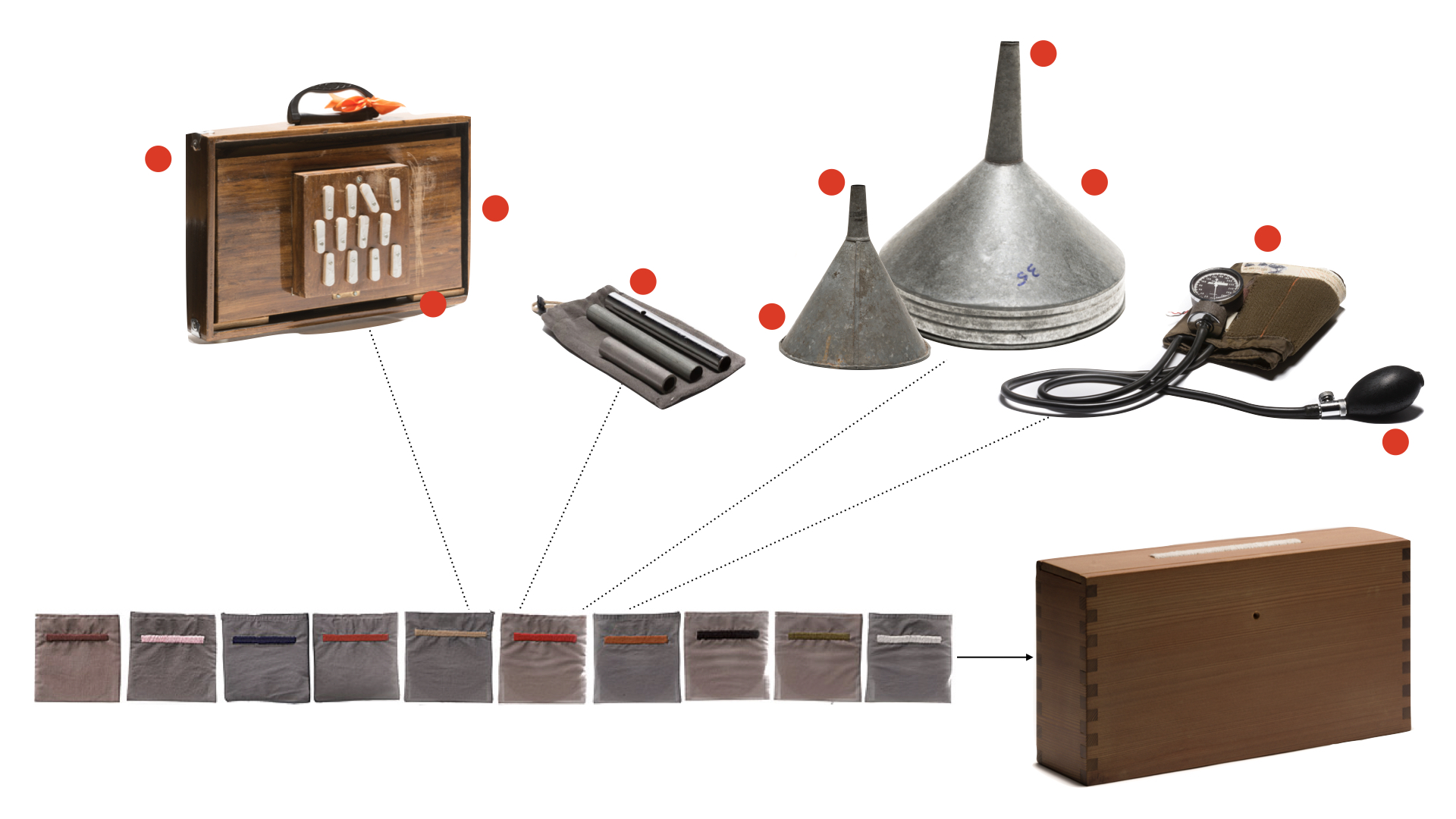
Figure 1. Objects recorded for the Vinculum archive, including a prepared shruti box, metal tubes, funnels of various sizes, and sphygmomanometer, with red dots indicating the recording perspective on each object. Between 2010-13 those recordings were collected in a series of hand-embroidered pouches containing three random discs each (bottom left). In 2013 all twelve discs in the series were collected in a limited edition of handcrafted specimen boxes, designed by instrument constructor Andrew Furse, that also included a brass tube and an integrated free reed (bottom right).
Vinculum’s collection of disturbances of air on material objects as captured by composed microphone techniques, and as digitally transformed, are regarded by Coppice as ‘specimens.’ These were collected in various handmade editions including hand-embroidered pouches, and a special edition wooden specimen box with glass mounted-CD’s.
Vinculum specimens have been introduced into other recorded compositions. Music writer Lucas Schleicher writes about the effect of Vinculum PC-1 04.01 003:57 appearing in Vantage/Cordoned:
Its presence will go unnoticed by anyone unfamiliar with the series, but just knowing that it’s there changes the way that Coppice’s music feels. It puts the stress on process rather than completion and softens the ordinarily firm line between work-in-progress and final product, making the album less of a destination and more of a way station. It’s a place where new techniques can be tried out with older, more familiar ones, where [sounds] can be made to move both backward and forward in time simply for the sake of testing those waters. Assuming that the sounds are just as flexible as the machines that make them possible, why not reuse the sounds, too?
Some might call that process remixing and wonder why anyone should find it so unique. In the case of Vantage/Cordoned, it comes across more as recycling than as remixing. The music, as fascinating and physically impressive as it is on its own, points away from itself and underscores the systems that bring it to life.²⁰
The Vinculum collection became a resource for a series of performed installations that studied the relationships between audio and audience in spaces. Specimens were inserted into those performed installations in spatialized listening settings. Being recordings with characteristically material qualities, these rendered new sensations of objectness in each spatial configuration and listening context.
The 2011 performed installation Vinculum (Courses) displays the process of what Chion calls “systematic acousmatization.”²¹ The acousmatic describes a situation in which one hears a sound without seeing its cause, whereas systematic acousmatization refers to the automation or mechanization of this effect by sound recording and reproduction technologies. Chion describes the acousmatic situation as “[cutting] both ways […] sometimes it helps us attend to sound itself; and sometimes, on the contrary, it results in the idea of the cause taking hold of us, haunting us, and monopolizing our attention. It is really rather the principle of the repeatability of fixed sound that allows us to make it into an object and to study it.²²
Vinculum (Courses) stages a sequential production of sounds with their sources and causes in clear view, and their subsequent systematic acousmatization and electronic transformation. While this process is characteristic to live electroacoustic music, Vinculum (Courses) brings attention to the making, capture, and transformation of sound, in steps, for a seated audience. Sounds were first produced using free reeds that were mouth-blown, then hand-pumped using a prepared shruti box and plastic tubing. Simultaneously those sounds were recorded, silently manipulated, and diffused across eight loudspeakers in wooden filters (Figure 2) once digitally transformed, while a final live accordion passage alluded to both direct and reproduced sounds. The variation Vinculum (Courses) [Version Baschet] (2011) was adapted for François and Bernard Baschet’s Aluminum Piano (1962), with pump organ, prepared shruti box, and electronics.
The published recording of this live work is heard from the perspective of the microphones on stage and the electronic processes as captured directly within the computer software. At the exclusion of any sense of spatial acoustics from the music venue where the performance took place, the audio signals that were scattered across the eight speakers were collapsed into stereo.
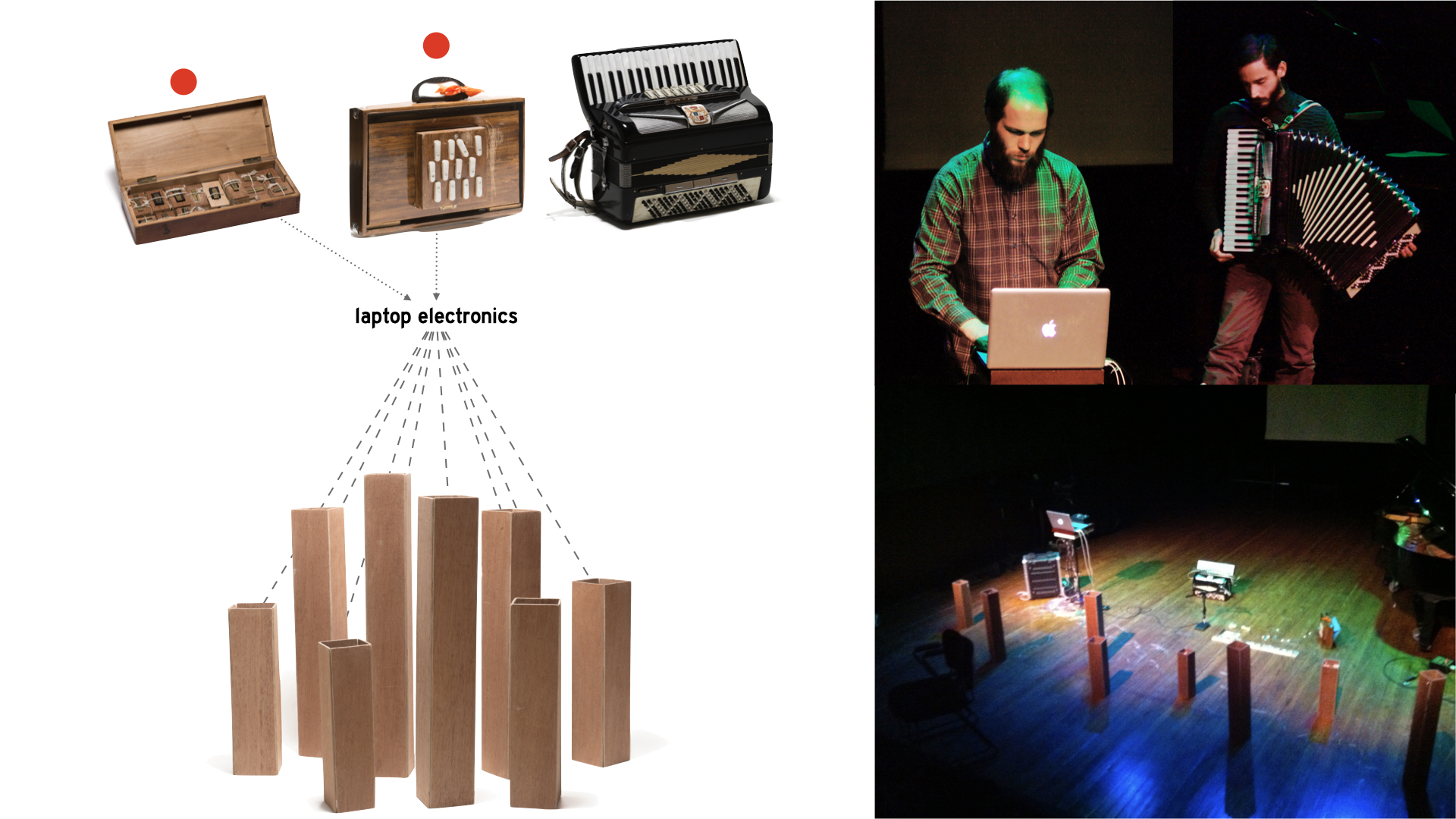
Figure 2. Simplified instrumental and diffusion scheme for Vinculum (Courses) (2011), performed installation on stage for a seated audience, with free reed boxes, prepared shruti box, plastic tubing, accordion, and eight small loudspeakers in wooden filters, with red dots indicating recorded objects. Performed and recorded for Music With a View, curated by Kathleen Supové at The Flea Theater, New York, NY, March 25, 2011. Performance photographs by Arthur Kaye (top) and Meg Kramer (bottom).
The performed installation Copse (2010) also juxtaposes acoustic and recorded sounds from a prepared shruti box, with additional playback of audio from the Vinculum archive (also of the same shruti box). These sounds were diffused across a family of eight loudspeakers, this time without wooden filters. The loudspeakers were placed in a decentralized arrangement that the audience traversed and gathered around, creating a radial rather than frontal listening experience that listeners could get close to and far away from.
In contrast to Vinculum (Courses), the electronic processing in Copse was performed electromechanically using Coppice’s Modified Boombox I, which is characterized by delay and controlled feedback using custom cassette tapes that pass tape from one tape head to another. While multichannel diffusion was digital in Vinculum (Courses), that of Copse was electroacoustic and manual through the use of Coppice’s custom Inductive Mixing Table I. Designed to bring signals into the electronic domain from the electromagnetic domain, the table pairs with a multichannel power amp to pick up signals from speakers and other magnetic sources and dispatch them to loudspeakers in a space. The spatial layout of the pickups on the table itself is meant to reference the location of the sound sources in the performed installation space (Figure 3).
For the stereo arrangement of Copse for 7” pressing (titled The Pleasance & the Purchase), we also opted for strategizing the collapse of the spatial spread of the performed installations at the exclusion of any spatial acoustics, as a means of representing the sonic content up-close: a specimen music. By excluding spatial context, the playback of these works is able to render the loudspeakers as sculptural reproducers of sounds in fidelity to the original performed installations, and not a representation of those performances. Lacking the performative spatial distribution, these recordings create other situations depending on a listener’s choices (placement, volume, setting, etcetera).
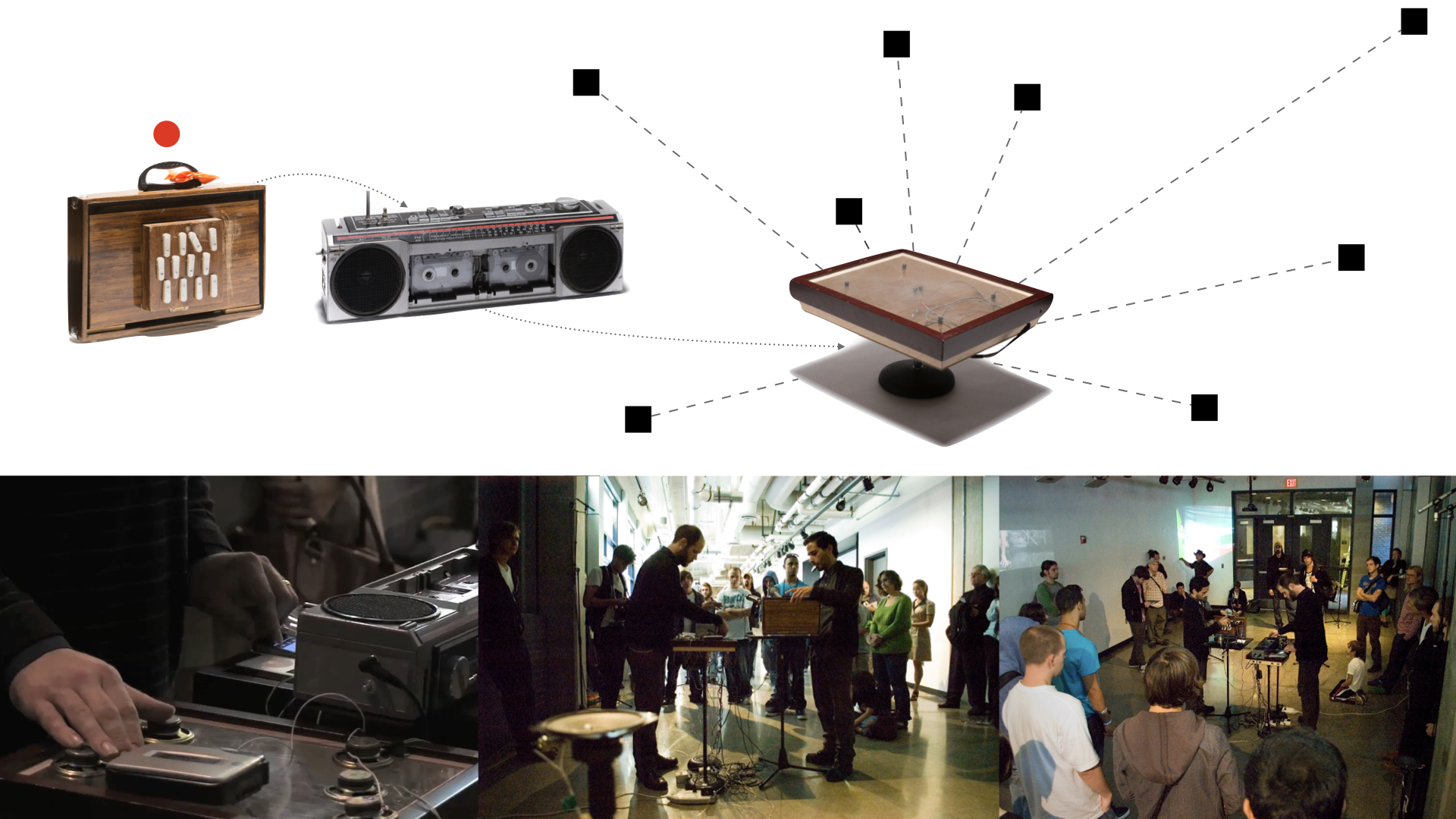
Figure 3. Simplified instrumental and diffusion scheme for Copse (2010), with prepared shruti box, Modified Boombox I, and Inductive Table I, as well as pitch pipes, harmonica, and a funnel (not pictured), and eight small loudspeakers (indicated by squares) in a decentralized arrangement intersected by a flowing audience all around. Performed for the Spark Festival of Electronic Music and Arts, Regis Center for Art, University of Minnesota, Minneapolis, MN, September 30th, 2010. Performance photographs by Spark Festival (left) and Andrew Amundsen (middle and right).
Similar negotiations for rearranging spatial installations into stereo productions were further explored through Vinculum (Coincidence) (2011), a series of performances of live and reproduced sounds that took place in a large museum space filled with works that are meant to be interactive. Museum visitors would wander in that space, entering, touching, stepping on, and sitting on works of contemporary art while we wandered, busked, with accordions strapped on.
Unlike the previously mentioned works, in Vinculum (Coincidence) the audience and us as performers were all in motion, constantly shifting auditory perspective and experience (Figure 4). Four stationary loudspeakers played randomized selections from the Vinculum archive, some sounding perceptually identical to the live accordion passages occurring simultaneously in situ. Juxtaposing live and reproduced sounds, but at the exclusion of any signal processing, this work brought to the fore disorientation in apprehending live and reproduced sources of sound, and delocalization in the large space.²³ In motion, the accordions excited the space’s acoustics in varying ways that augmented that disorientation.
Given the space’s reverberant quality, its acoustics further blurred distinctions between live and reproduced sources, unless a listener’s physical proximity to those sources (an accordion or a loudspeaker) canceled their otherwise acousmatic listening experience. Crucial to this perceptual effect are the recording techniques used on the same accordions performed with on site, whose high definition capture resulted in high fidelity reproduction in proportion to the loudspeakers, as a kind of induced auditory mirroring.
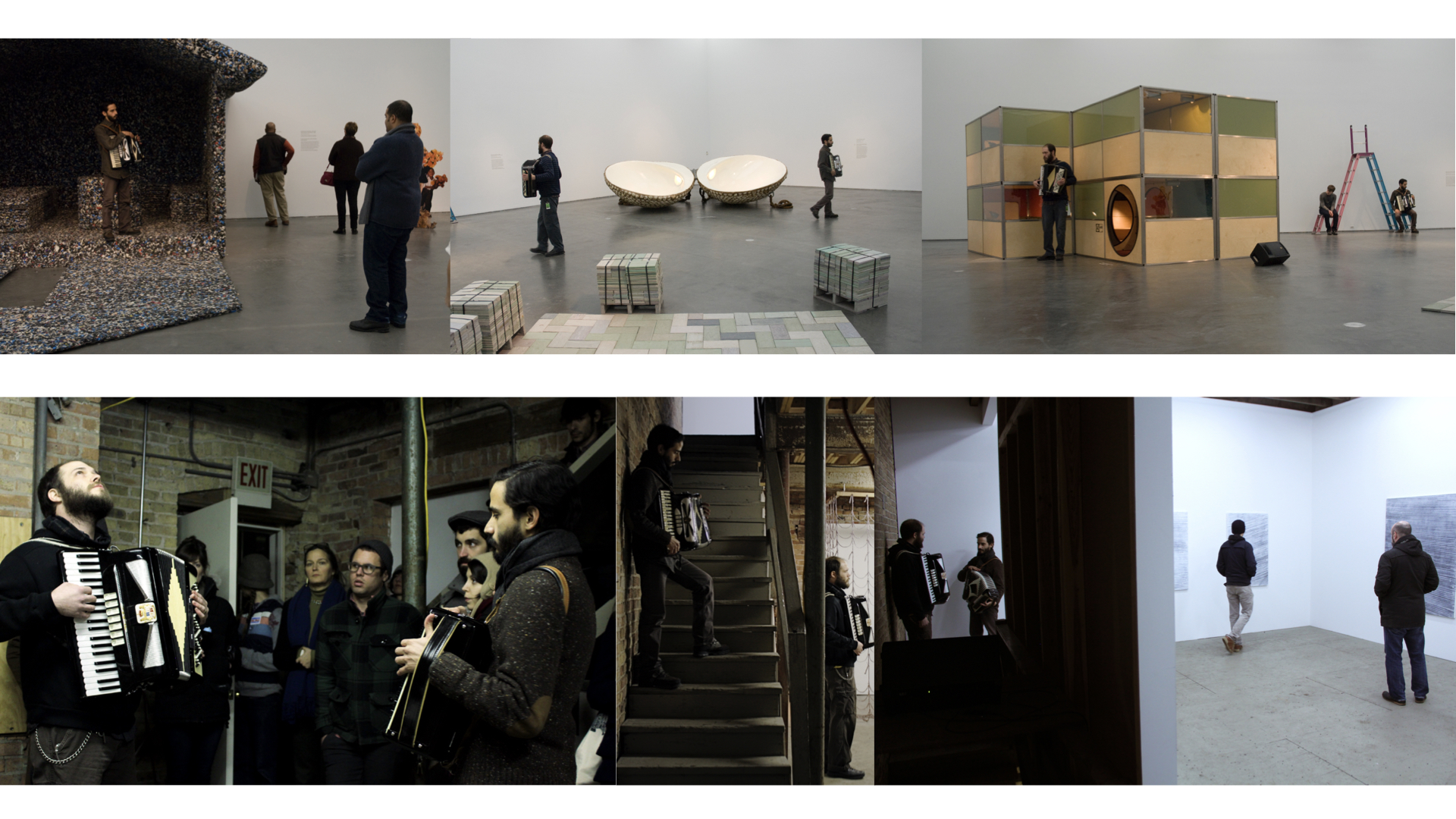
Figure 4. Vinculum (Coincidence) (2011), for four fixed loudspeakers playing aleatoric audio from the Vinculum archive, and two accordion performers in motion. Performed among artworks by Dan Peterman, Vito Acconci, Andrea Zittel, among others, for Without You, I Am Nothing: Interactions, curated by Tricia Van Eck at the Museum of Contemporary Art Chicago, February 8-13, 2011 (top row); and among artworks by Cameron Crawford, John Almanza, and Maya Pik for Coppice/Pik, curated by Chelsea Culp and Ben Foch at New Capital, Chicago, January 29, 2011 (bottom row). Photographs by Nathan Keay (top row), Doug VanderHoof (bottom left and right), and Kelly Kress (bottom middle).
Several other iterations of the piece were performed, one in a crowded public space where we moved close toward or far away from listeners amid a social context, one in which the performance was neither necessarily focal nor ambiental. In another occasion we performed together and apart across two floor levels for a scattered audience, bringing auditory awareness to verticality in listening (Figure 4). In all of these performances, listeners (including us) were active toward the music in their (our) spatial participation with it, as well as individual subjects for the music itself to shift spatiality and affect for.
In arranging Vinculum (Coincidence) for stereo recording, spatial acoustics were again intentionally excluded from capture when recorded in a studio. What was originally meant to be perceived spatially and durationally was flattened and scaled down to the maximum duration of a CD. While these transformations change the original work, the statement in this adaptation is to document a transposition of ideas from one medium to another, rather than present a documentary. The dichotomy between documentation vs. documentary is a recurring concern in works over the years.
Part of such transposition from live to recorded media addressed the specific physical media itself, the CD. While the original live performances were aleatoric and ephemeral, whereas recordings are fixed and ‘reproducible,’ the CD arrangement was indexed into tracks that listeners may skip. Upon following the suggested shuffled listening stated in the liner notes, the work may be further fragmented into yet more aleatoric fragments in chunks not possible in a live setting.
Our concern with preventing the documentation of musical liveness from appearing merely representational of something that happened in a particular space, opting instead for a specimen-approach that excludes spatiality, the arrangement for CD titled Vinculum (Coincidence): Indexed Conjectures Of Coincidence Imprints Once Happened (2015), recalls composer John Cage’s remarks about recordings of indeterminate music:
A performance of a composition which is indeterminate of its performance is necessarily unique. It cannot be repeated. When performed for a second time, the outcome is other than it was. Nothing therefore is accomplished by such a performance, since that performance cannot be grasped as an object in time. A recording of such a work has no more value than a postcard; it provides a knowledge of something that happened, whereas the action was a non-knowledge of something that had not yet happened.²⁴
Coppice’s intention in re-arranging and re-titling this work is to re-contextualize its compositional ideas into a fixed and repeatable listening as afforded by its specific media.
Shifting Vantage Points and Speculative Vanishing Points
In development of live repertoire that we could tour with, we composed works for stereo amplified prepared bellows and electronics. Stereo amplification was considered for its rendering of multiple auditory vantage points, to represent our instruments and devices in sculptural ways in a frontal staged manner. Not dissimilar to earlier recordings, our live amplification technique consisted of corresponding the front and back of a prepared shruti box with the left and right of the stereo image, and the left and right of the modified boomboxes with the left and right of the stereo image as well.
In a speculative sense, these recording and amplification techniques present a superimposition of dual two-point perspectives: an instrument and a device sounding together, each captured from two different points. Visually speaking, two-point perspective refers to an object’s reference to two vanishing points. Speculating in terms of the auditorily and the spatial, we selected two points in each of our instrument and device as focal points to render a sculptural duo objectness (Figure 5, bottom). This technique has been used in many Coppice works, as part of what we refer to as specimen music.
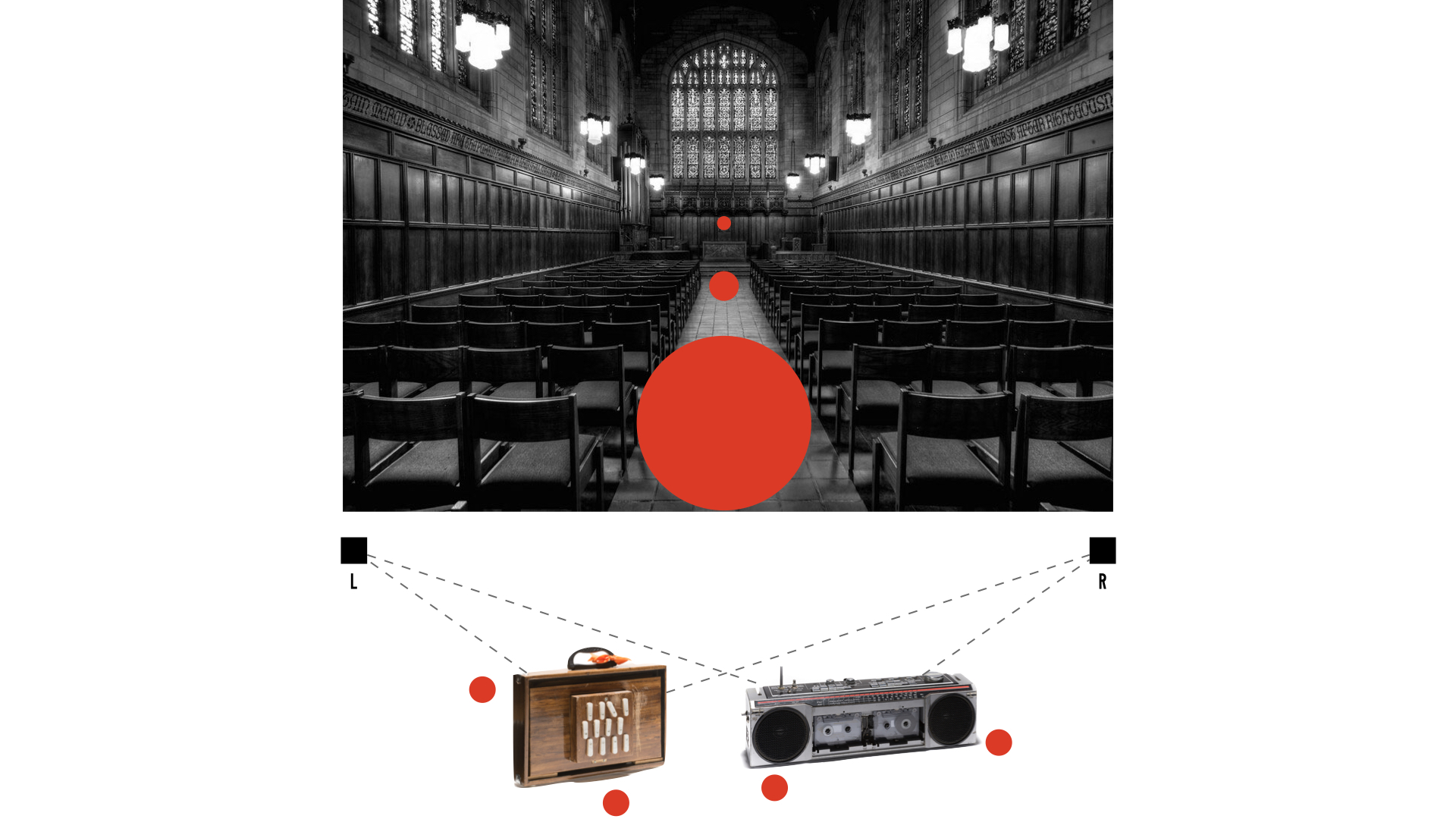
Figure 5. The Joseph Bond Chapel (1926), University of Chicago, where two works from Coppice’s Spans: Three Perspectival Accounts (2015) were recorded on November 6, 2011. The red dots across the nave indicate simplified spatial markers where microphones were placed to document the performance. Those points were mixed in post-production to evoke shifts in auditory perspective, and of spatial acoustics, relative to the original music’s sources (bottom) at the choir. Chapel photograph by Alan Amati, treated by Coppice.
Building upon these techniques, we explored ways of documenting our live performances in interaction with the spatial acoustics of a given performance venue. A 2011 staged performance at the Bond Chapel in Chicago was captured using the dual two-point perspective mentioned, as well as from multiple points in the performance venue (Figure 5, top). In post-production, those multiple points were faded between to create an elaborated documentation whose perspective glides across the space, altering the acoustic presence and vantage point on the music.
Rather than presenting a fixed documentary perspective of the performance, this pull focus-like effect acts subtly yet dramatically upon the music, and compositionally upon the documentation. This effect renders motion in the auditory perspective as if the auditory vantage point receded from the choir area where the performance was staged, back across the nave, and up to the rear balcony. While the recording is fixed by its very nature, it is its represented auditory perspective that shifts, from close proximity to instrumental materialities to a widening spatial depth and architectural areas where the music occurred. This effect is used in tracks one and three of the album Spans: Three Perspectival Accounts (2015).
A contrasting way of capturing a live performance is our customary exclusion of spatial context, similar to that described in the previous section. Compound Form (composed in 2012, published in 2013) is an unaltered recording of a live performance from the perspectives on the instrument and of the device (in a dual two-point perspective) at the exclusion of the venue’s acoustics, thus the same audio signals amplified in the space for the audience for whom the performance took place. Given this, the playback of Compound Form on a stereo system positions the listener in fidelity to that performance context and what the audience heard in other spaces.
Through these negotiations of contexts between live and fixed mediums we have questioned how music is presented and re-presented, and how compositional identity may be adapted. Regarding our speculation of auditory vantage points, we question what vanishing points may be or stand for in the auditory dimension. On one hand, vanishing points refer to the points that capture our instrumentation, on the other, they refer to the loudspeakers that reproduce those points, and in turn, address the listener’s audition in their own conditions. This speculation is playful reverie in consideration, similar to Chion’s remark that “there is no sonic frame for sounds,”²⁵ of media theorist Marshall McLuhan and Edmund Carpenter who write:
Auditory space has no boundaries in the visual sense. The distance a sound can be heard is dictated more by its intensity than by the capacity of the ear. We might compare this to looking at a star, where visual sensation, transcending the vanishing point, is achieved, but at the sacrifice of the precise framework we call visual space. There is nothing in auditory space corresponding to the vanishing point in visual perspective.²⁶
Adding,
Auditory space has no point of favored focus. It’s a sphere without fixed boundaries, space made by the thing itself, not space containing the thing. It is not pictorial space, boxed in, but dynamic, always in flux, creating its own dimensions moment by moment. It has no fixed boundaries; it is indifferent to background. The eye focuses, pinpoints, abstracts, locating each object in physical space, against a background; the ear, however, favors sound from any direction.²⁷
In this sense, our experiments with auditory vantage points and vanishing points are fantastical. Auditory space as a shapeshifting whole leads us back to Chion’s concern with the difficulty of sounds’ spatial isolation, quoted here a second time for flow and clarity:
[The difficulty] of isolating in space a sound that one would like to study in relation to others that exist at the same time. It is impossible for us to “zoom in” on a sound when others resonate simultaneously with a similar force. […] [T]here is no sonic frame for sounds.²⁸
The difficulty of spatial isolation of sound acoustically, yet also within the ‘frame’ of a stereo recording, is explored in greater concentration in the works Soft Crown (2013) and Soft Crown Transparencies (2014).
Soft Crown is a fixed stereo composition for a prepared Estey pump organ (ca. 1930s), specimens from the Vinculum archive, tape processes, and material filtering. While previously we described how our instruments and devices had each been captured using primarily two microphones (or vanishing points) to compose a dual stereo image relative to two sides of each instrument and device; the prepared pump organ for Soft Crown was recorded from ten different points inside and around the organ. Those ten points were individually controlled using Coppice’s custom Estey Expander Module, and fed to electronic processes where they were mixed (Figure 6).
While those ten points created a sonically richer audio capture, they still suffered reduction to stereo. Inspired by the differences in nuance between each of those ten spatial perspectives, we devised a way of representing navigation through layers of music. Soft Crown is available as a fixed stereo mix, and as a navigable stereo mix in the form of custom software. The fixed form is a stereo track on a CD or a digital file that is played back and then ends. The navigable form re-titled Soft Crown Transparencies is a desktop app designed specifically for traversing the various layers of audio heard in the stereo mix, and additional audio exclusive to it. As the music plays, the listener uses the up and down arrows on the computer keyboard to navigate through different layers of sound at the exclusion of others. As the music progresses, a listener may change their vantage point on the music and instrumental textures as they flow. This work is interactive in the sense that the auditory vantage point, or perspective toward the composition as a space and as an object, may change. The course of the composition itself, however, does not change.
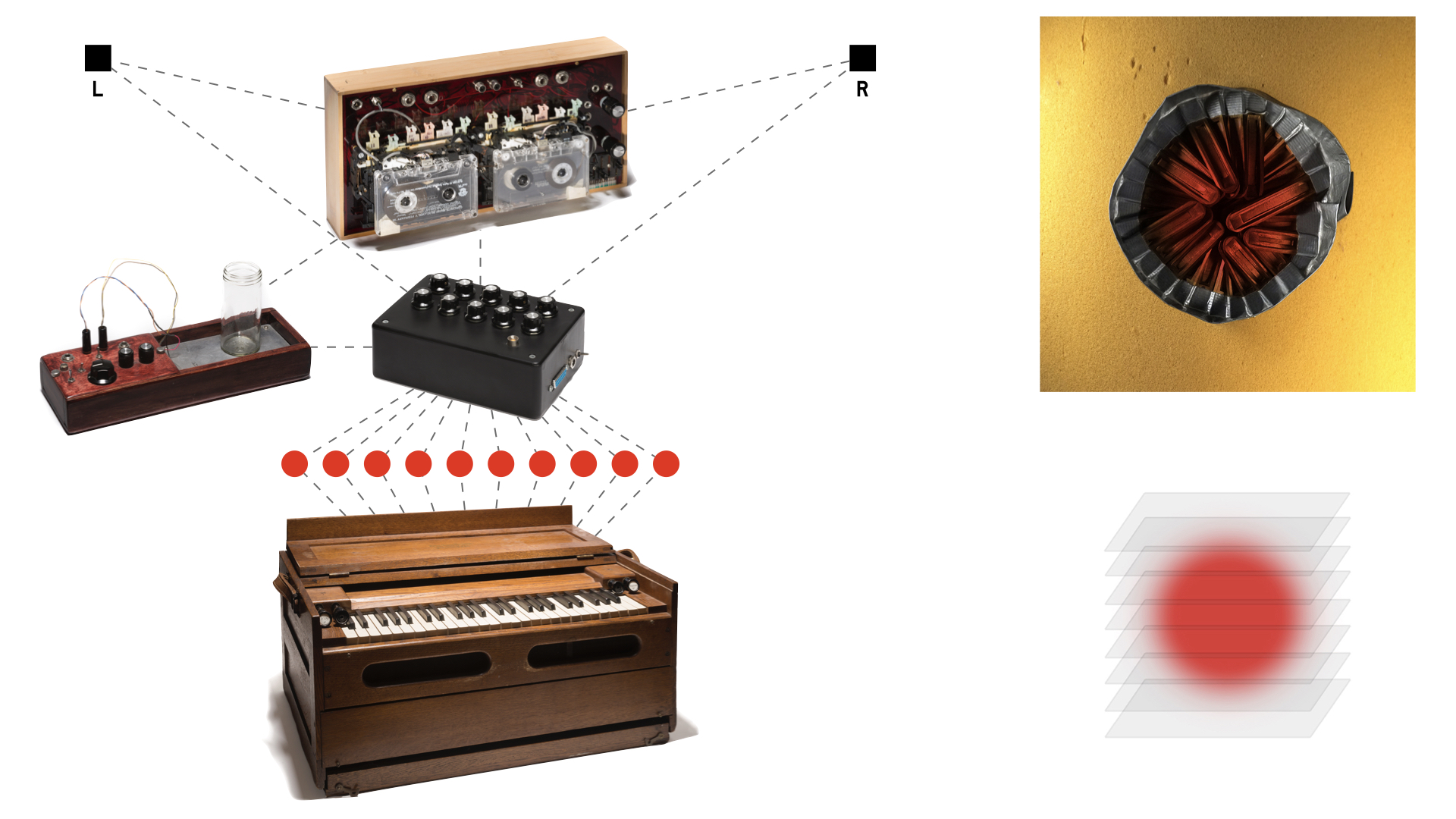
Figure 6. Simplified production scheme for Soft Crown (2013), with red dots representing ten unique recording locations on a prepared Estey pump organ (bottom) being mixed by Coppice’s Estey Expander Module (middle) and through the Multi-Material Filter (left) and Modified Boombox IV (top). A fixed stereo mix of Soft Crown is heard on Vantage/Cordoned (2014) (cover artwork by Coppice, top right), and as a navigable dynamic stereo mix via custom software by Coppice on Soft Crown Transparencies (2014) (cover artwork by Coppice, bottom right).
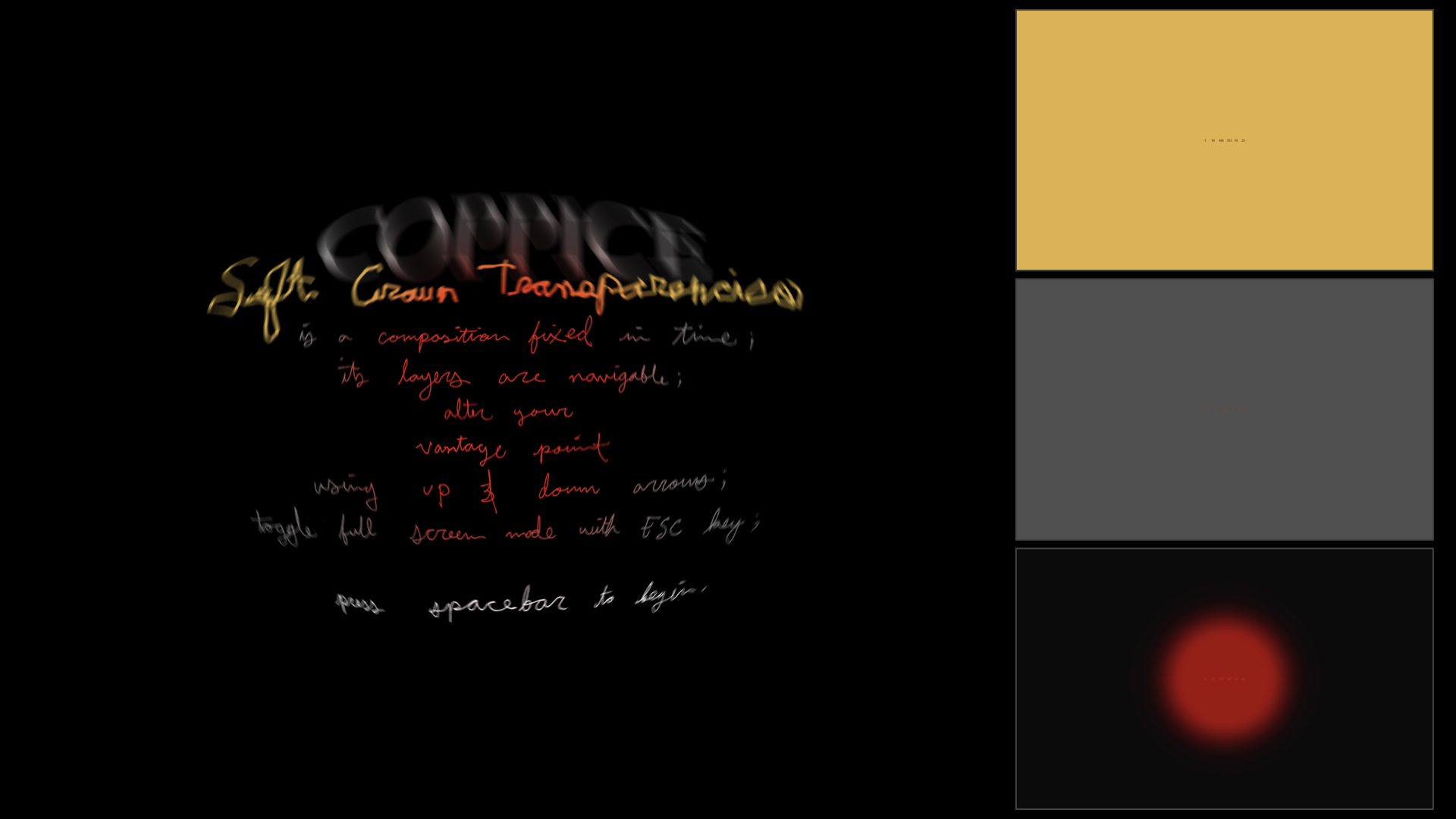
Figure 7. Welcome screen of Coppice’s Soft Crown Transparencies (2014), custom software for navigable stereo listening (left), and three screenshots displaying the zones navigated between using the up and down arrow keys as the music progresses (right).
Shown on figure 7 are the instructions displayed on the welcome screen: “Soft Crown Transparencies is a composition fixed in time, its layers are navigable; alter your vantage point using up & down arrows; toggle full screen mode with ESC key, press spacebar to begin.” This welcome screen leads to the beginning of the piece, heard against a timer on a gray color on screen that represents the middle vertical point of the navigation system. Pressing the up arrow slowly shades from gray into yellow, and pressing the down arrow shades back to gray into black. A red spot appears on the center of the screen to represent movement through those colors, layers, or transparencies of sound when an up or down arrow keys are pressed. No marker other than a timer is indicated. A listener only has their ears to be guided through the various textures and densities that they prefer to ‘zoom into’ or recede from.
Navigating Soft Crown Transparencies is smooth and fluid. Inversely, Pied (2012), a fixed stereo composition, is a scored work that suddenly punches through multiple generations of tape processes to reveal layers of sound effects as if strata (Figure 8). Through these works, we have investigated how sound recording and reproduction technologies, whether as designed, or modified, or custom-made, may be used to evoke the auditory sensation of cross-sectioning music and slicing layers of sound.

Figure 8. Score for Pied (2012), showing five layers of generations of tape processing on a recorded pump organ.
The works described in this section display different strategies for technologically capturing sound while creatively adapting ephemeral works to fixed media, with fantasies of traversing music as if a space or object. While the two tracks in Spans represent the spatial acoustics of the performance venue where the performances were recorded, Compound Form excludes such spatial context in favor of direct sound. While Spans represents a drifting across the performance venue (shifting auditory perspective from instruments on stage to the back of the space) in a fixed recording, Soft Crown Transparencies grants the listener choices for their own drifting across layers of music, and thus instrumental zones: prepared pump organ, filters, multiple generations of tape processing, and varying blends of these.
These strategies toward composition and documentation alike intentionally refuse conventional auditory documentation of performances or instrumentation. Instead, they creatively strategize shifts in spatialities to bring depth, dimension, and identity forth for audition.
Multi-sidedness and Turning
The works and operations in the previous section evoke spatial dynamism with regard to stereo media (CD, digital files, software). Those in this section conceptualize how compositions can be both objectified and spatialized in physical recording media itself: the cassette tape. Exploring the isolation of sound more conceptually although no less technically, they further propose sidedness in music, and turning as part of its spatial listening experience.
Bypass (2013) is a composition for heavily amplified prepared pump organ and tape processes using Modified Boombox III, a tape processor. This was one of the first pieces composed at the exclusion of signal processing between the duo, making possible the boosting of amplification with no threat of audio feedback. The perspective of the work follows the same technique as previous works, dual two-point perspective (corresponding the left and right ends of a pump organ keyboard with the left and right of the stereo image, and the left and right of the Modified Boombox with the left and right of the stereo image as well).
For its publication as a cassette tape, Bypass Ideal (2015), that dual two-point perspective was separated and placed on each side of the tape, so that they are listened to in isolation rather than in the original superimposition. The tape, then, does not represent the duo performance itself, but an idealized experience of parts, two solos, with the instrument and the device parts each standing alone on their respective side of the tape. This arrangement, writer Lucas Schleicher writes, “effectively [destroys] the performance in favor of focusing on its building blocks, all the way down, it seems, to the atomic level.”²⁹
While visual perspectival analogies are not naturally equivalent to the auditory experience, they act as poetic provocations for sensing the sculptural techniques with which Coppice’s compositions are created in exploration of sidedness to and thus perspective toward its music (Figure 9). A listener’s active participation, sonic thinking and auditory imagination, may perceive these sides, engage with, and hold them.
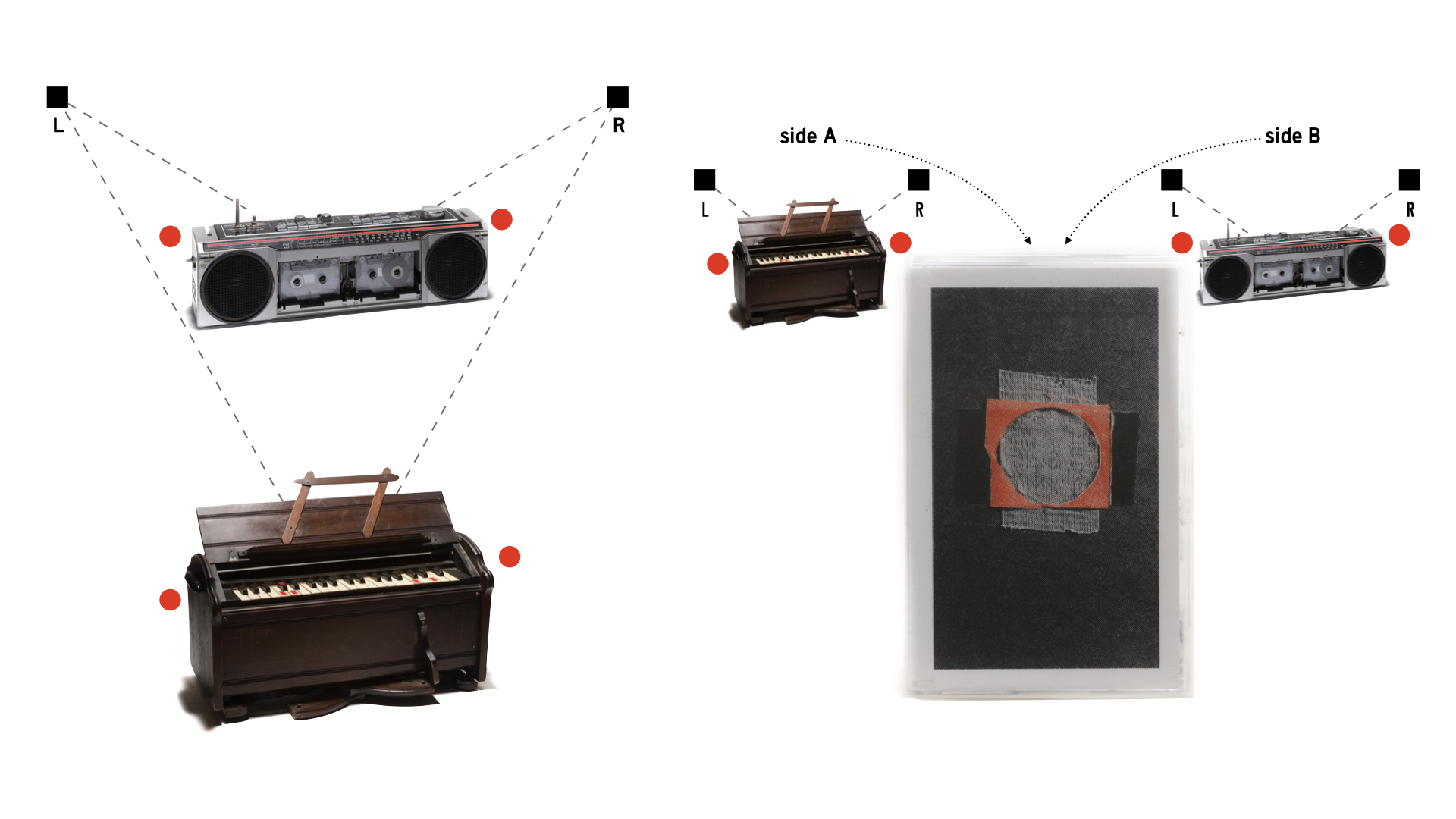
Figure 9. Simplified performance scheme for Bypass (2013), for amplified prepared pump organ and tape processes (left); and illustration of compositional arrangement for fixed recording, Bypass Ideal (2015), showing each instrumental part’s stereo correspondence on each side of a cassette tape (cover art by Coppice, right).
Going further, the 2018 cassette tape XYZ compositionally explores a double-sidedness of music by placing two pairs of songs on each side of the cassette tape, each song a variation of another on the opposite side. Dense Day Cooling (Ventral) on side A is a fully produced song, while its counterpart Dense Day Cooling (Dorsal) on side B strips away much of the production and leaves only certain sonic traces. Similarly, Fake Memories Object (Antecedent) on side B is a fully produced song, while its counterpart Fake Memories Object (Descendant) on side A is a reduced version that is more stripped down. The listener is to engage with the tape and the songs sculpturally, as if turning a physical object, such as the tape itself, to listen to a song from different sides. It is not just the cassette tape that is turned, but also the songs in memory of their perceived spaces, properties, and relations.
Interiors, Exteriors, and Mnemo-Perceptive Effects
Up to this point, Coppice music has been described by music writers as “[crafted] fictional locations,”³⁰ while “[not] so much [connecting] musical styles as [peering] deeply into the spaces between them in order to find sounds that flourish without framework or form.”³¹ Shifting away from a focus on phonofixation, recording and post-production techniques with electroacoustic objects, work between 2014–2018 hones in on phonogeneration with digital and analogue synthesis. Carried by an attitude of sound design and simulation, and addressing consumer device and gaming cultures, works from this period evoke scenery, imagery, and spaces in more dramaturgical ways than prior.
In low definition, Open On Occluded Conditions (composed between 2015-2016, published in 2017) makes heavy use of digital noise and audible artifacts from audio compression in both actual and simulated forms, to bring attention and hypermediacy to the digital context of consumer devices through which the work was directly shared.
In higher definition, Green Flame (2018) is an album driven by a psychogeography of place, with a sense of fiction and cinéma pour l’oreille feel without discernible characters. It is made up of three sections, opening on an exterior scene marked by a field recording of a ubiquitous urban drone with electronic figures masked within it; and closing on an interior scene produced in a similar way to Spans, by mixing various recording spots in different rooms adjacent to one another, close to and away from different instruments and their power sources. The middle section is less prescriptive of a sense of physical location, rather expressing sensations of environments, a dream space. Following the album’s concept of a journey in a vehicle (music for driverless dream cars on their self-driven way to the junkyard), the work’s titles describe travel, and display two contrasting arrangements of the same melody, Afterthought/Country Road versus Cul-de-sacs/Ashdown, bridged by Here, a metamorphic transition between their differing sceneries and moods.
Green Flame suggests the metabolic effect, a term proposed by philosopher and musicologist Jean-François Augoyard and sociologist and urban planner Henry Torgue:
[a] perceptive effect describing the unstable and changing relations between elements of a sound ensemble. A classic figure of rhetoric, metamorphosis characterizes the instability present in structural relations that link parts of an ensemble and the resulting possibility to switch elementary components of a totality, so it is perceived as being in perpetual transition. The ancient Greek word metabolos (in French “métabole”) means that which is variable – something that is in metamorphosis. Our considered modification here involves the relation between elements that compose the sound environment, defined as addition and superimposition of multiple sources heard simultaneously. […] The metamorphosis effect has two fundamental criteria: the instability of the structure perceived in time; and the distinctiveness of the parts or ensemble in a given sound composition.”³²
From a semantic point of view, musician and architect Björn Hellström describes sounds within the metabolic effect as “impersonal (which produce a feeling of euphoria), whereas the sounds in regard to ubiquity effect are anonymous (which produces a feeling of malaise),”³³ too corresponding with the ubiquitous urban drone, metabolic electronics, and characterless abstract sceneries of Green Flame.³⁴
Music writer Nick Storring wrote of Green Flame, “[o]ne of its more striking features is the strange and potent sense of locus. The locations illustrated therein may not always be fully identifiable by the listener, but there’s always an ineffable somewhereness. It serves as an agent of cohesion over the vast and varied album–and the track titles (“Here,” “Cul-de-sacs”) confirm this.”³⁵ Furthermore, Storring describes the effect of the music on his auditory perception, “[a]ll the activity of “Ground,” the opening and longest piece at twenty-two minutes, transpires over and within a sustained drone. Initially, the discourse appears completely abstract, but as the track progresses, you start to wonder if you’re apprehending real-world sounds entering the sonic image–particularly vehicular traffic.”³⁶
Green Flame’s album artwork includes a small map of cross streets where the music was recorded or produced in Chicago, to indicate psychogeographical markers, reflected upon by Storring in how “the various layers of [musical] activity seem positioned geographically–in certain cases there’s even a sense that a given sound is obstructing the view […] [seemingly navigating] space, rather than simply occupying a region of the mix.”³⁷ In Augoyard and Torgue’s terms, Storring’s experience refers to drone, blurring, mask, imitation, and delocalization, the latter paradoxically coinciding with his perceived sense of locus.³⁸
Revolving around ideas of reflection, inversion, turning, and reversibility in the auditory, selections from Green Flame and XYZ were performed spatially during an artistic residency at Silent Funny, a 5,000 square foot building in Chicago. Divided into two near equal chambers with two openings between them, one through which the audience flowed, and the other obstructed by our performing (Figure 10). Multiple speakers of various types were placed in a decentralized manner throughout both spaces, evading any semblance of an auditory sweet spot. The audience was invited to wander throughout the darkened space, take a seat, and shift auditory vantage points whenever desired throughout the concert.
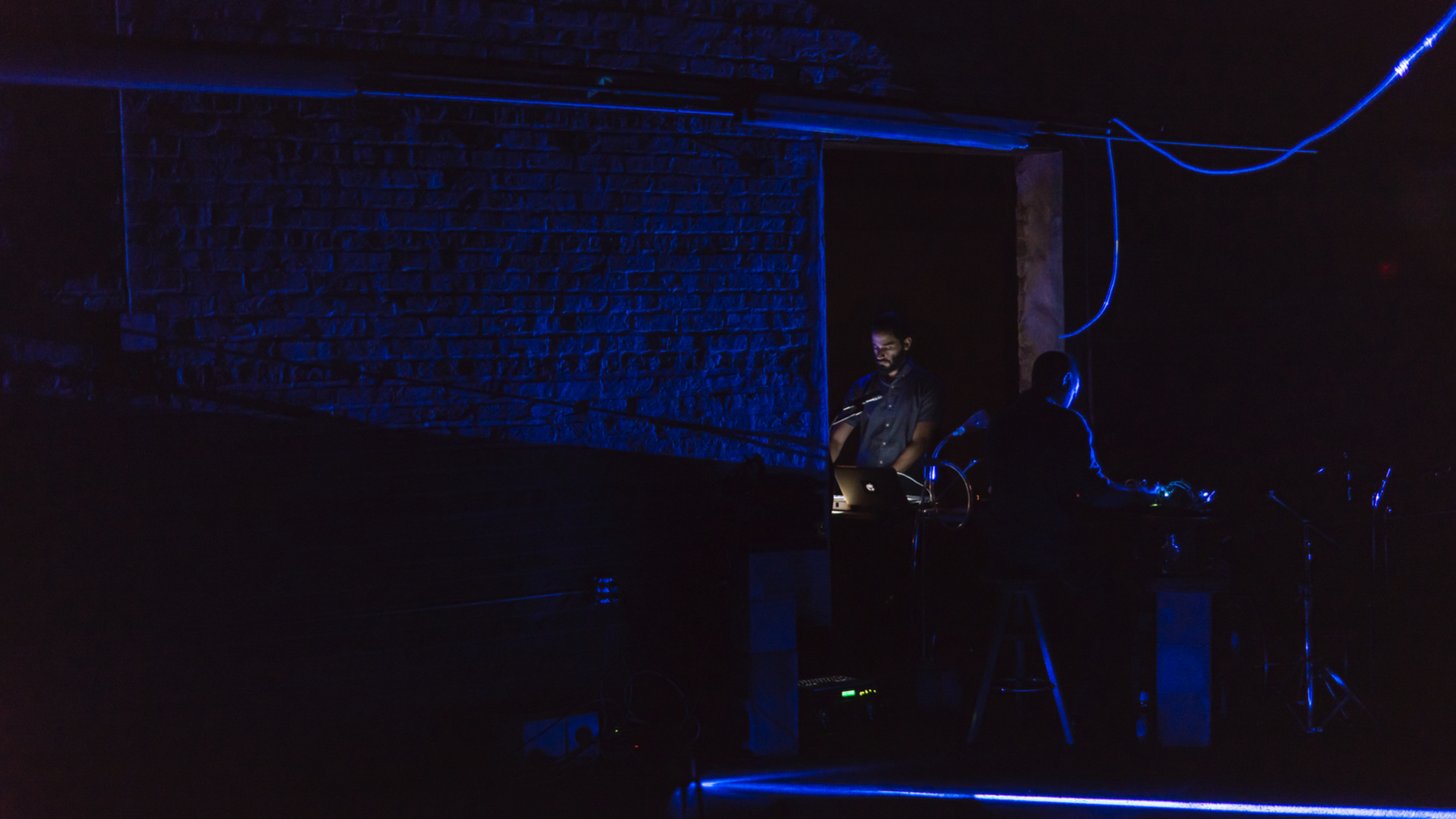
Figure 10. Coppice performing between two chambers during Turning Concert, Silent Funny, Chicago, August 27, 2018. Photograph by Nathan Keay.
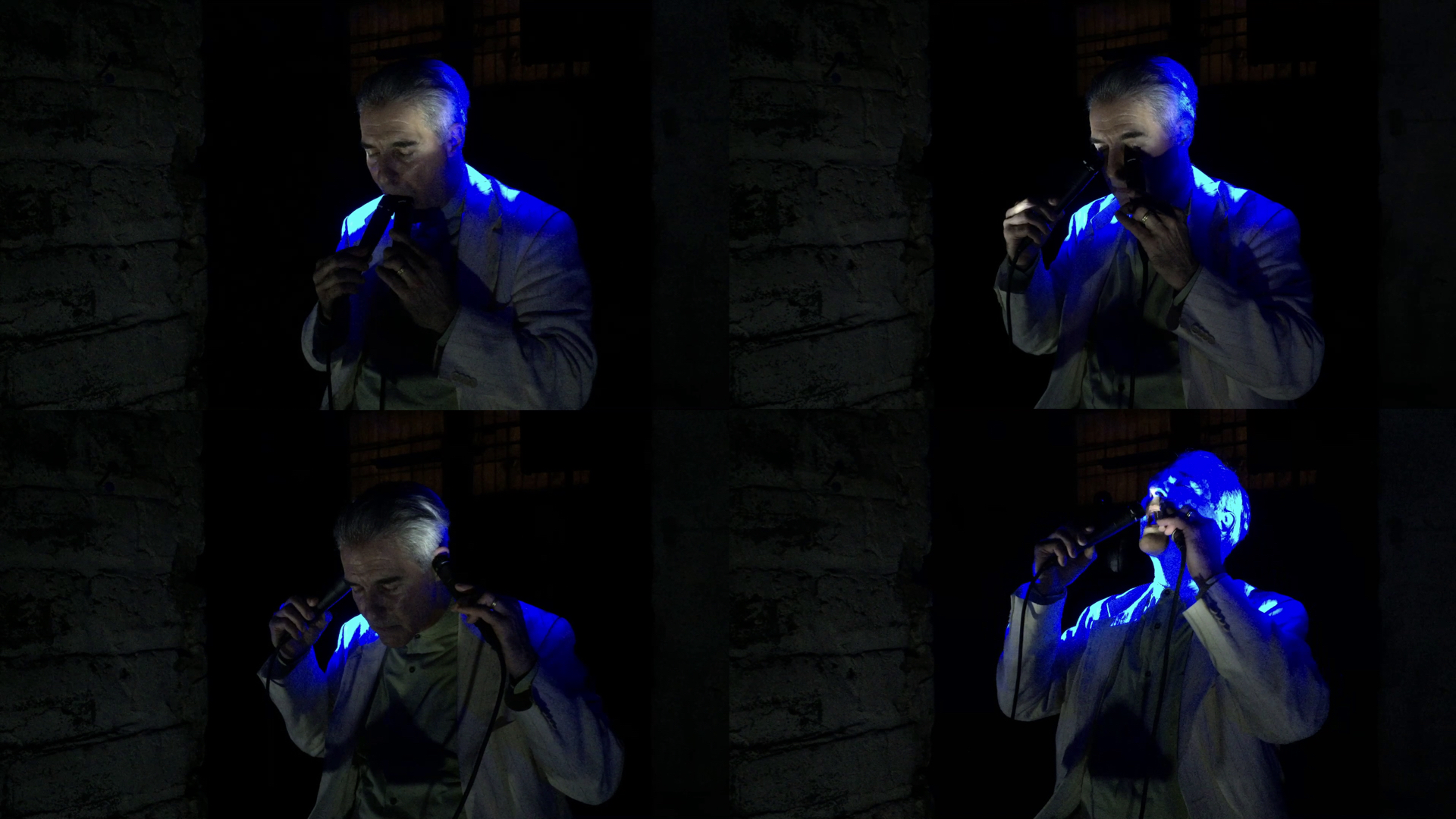
Figure 11. Still images from video of sound artist Lou Mallozzi performing with Coppice using his mouth, nose, and ears to create controlled feedback in a pair of drones that shifted pitches and beating patterns, each amplified in its own chamber in a 5,000 square foot building. Performed during Turning Concert, Silent Funny, Chicago, August 27, 2016.
The performance titled Turning Concert (2016) included a collaboration with sound artist Lou Mallozzi, who sat between one of the openings between the chambers wearing headphone-mounted metal tubes, each about twenty feet long and three-quarters inch diameter. Coppice performed quiet sounds into his ears through the tubes, as he then improvised vocal sounds into two microphones in response to what he heard. Each of his two microphones were amplified into each chamber to his sides, creating a large-scale stereo split that was architecturally reminiscent of the coupling effect, the “[i]nteraction between two sound phenomena that seem to be distinct yet connected, without being necessarily engaged in a causal relationship.”³⁹ In architecture, the coupling effect entails “the reciprocal influences of different reverberations of two adjacent spaces,”⁴⁰ a threshold available to listeners of Turning Concert.
A second improvisation with Mallozzi used two microphones in and around his mouth, nose, ears, and overall face, to create controlled feedback between his facial cavities and the bifurcated architecture into which it was amplified (Figure 11). Here, spatial composition took place not only across the large footprint between the two chambers, but also in small facial areas as Mallozzi himself became a source material, instrument, and processing device, in extension of the architecture and of Coppice (and vice versa).
Sonic Frames and Spatiotemporal Synthesis
Following the two periods of study in bellows and electronics (2009-2014) and physical modeling and modular syntheses (2024-2018), Coppice turned its focus away from musical instrumentation, and toward devices of capture: microphones, cameras, and language. The short video work Chrome/Boundaries Scaling Stereo Images and Promises (Some False): Viewing Microphones and Listening Cameras (2018) is made up of short vignettes that consider the relations between what is seen and what is heard within the audiovisual frame of digital video with sound. More conceptual than musical (even by experimental music standards), the work is Coppice’s first of several direct artistic responses to Chion’s statement that “[t]here is actually no frame for sounds in the sense that word has for the visual register, namely, a container with borders that delimit at the same time that they structure what they enclose.”⁴¹
Among its vignettes, one visually displays two identical microphones, creating a playful, yet inaccurate stereo pair and a pun for ‘stereo image’ (Figure 12). In other vignettes, musicians David Toop and Phil Niblock (Figure 13) are heard sharing musical memories of 1961 and 1989, corresponding with the model years of two Shure Unidyne microphones they held while being recorded speaking, 55SW from 1961 and 55SH Series II from 1989, figuring yet another playful stereo pair and image.
Visually and auditorily, these vignettes muse over stereo as a frame of capture for sounds, while reflecting on the temporal configuration posed by each microphone’s model year, and in turn, the temporal bracket that they create when paired as a stereo image (left 1961, right 1989). Likewise, their respective audio fidelity may mirror the memories spoken into them, echoing memories’ fidelity to events told.
Microphones may frame but not reproduce sound, loudspeakers may play sounds back but not be able to contain them within a frame proper. In the audiovisual configuration of the digital video, the content on screen is a frame reflective of sound, transparent as to its contents, however no less convoluted than any other suggestion of what may be a frame, what may be meant to be framed, and what continued beyond a frame.
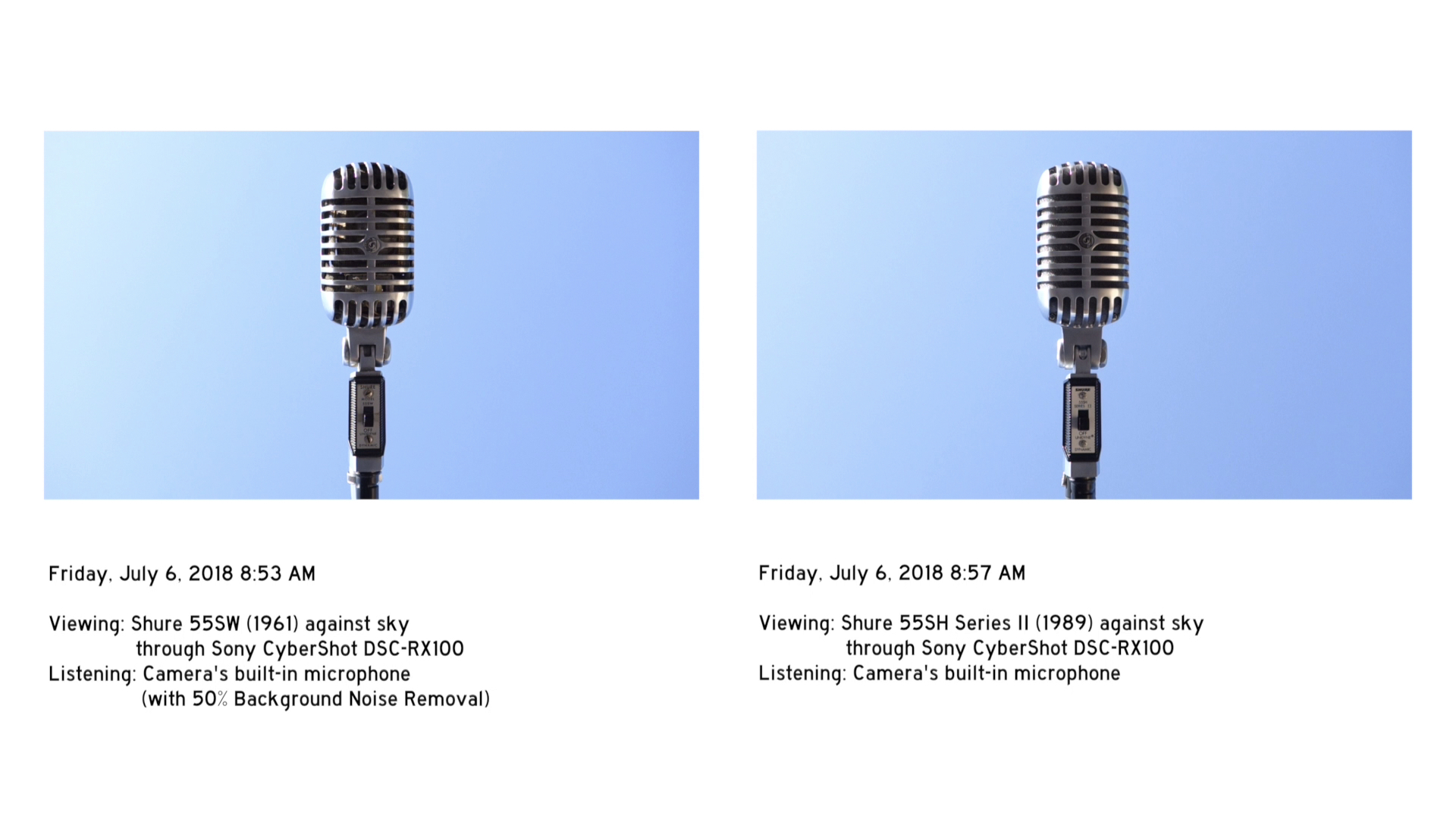
Figure 12. Still image from Coppice’s Chrome/Boundaries Scaling Stereo Images and Promises (Some False): Viewing Microphones and Listening Cameras (2018), video, 27 minutes.
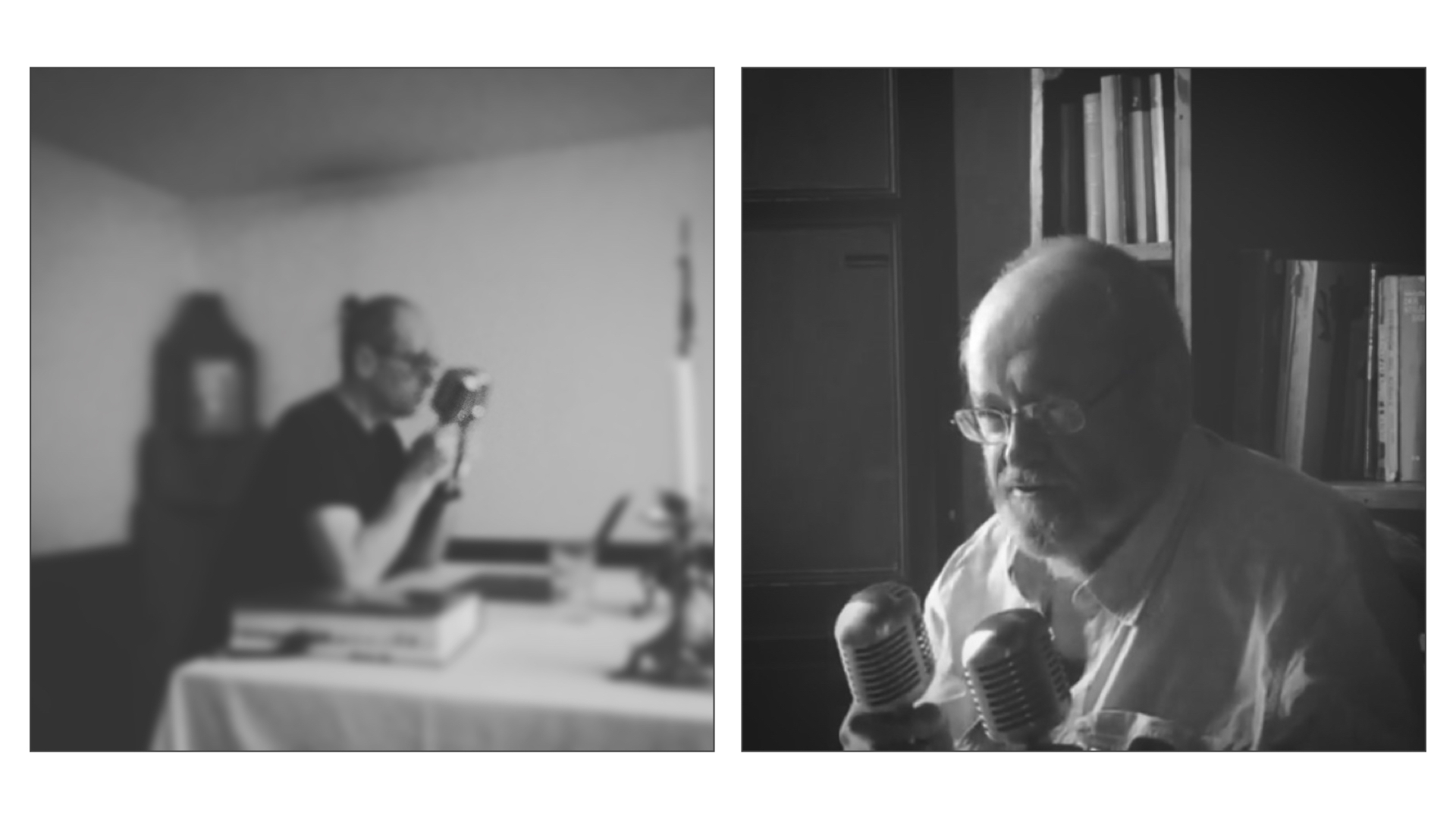
Figure 13. Musicians David Toop (left) and Phill Niblock (right) recording their voices for Coppice’s Chrome/Boundaries Scaling Stereo Images and Promises (Some False): Viewing Microphones and Listening Cameras (2018), video, 27 minutes; during Sounding Paths Residency at the Old Jesuit Monastery in Ano Syros, Greece, July 2018. Photographs by Noé Cuéllar (left) and Eva Matsigkou (right).
Chrome/Boundaries is Coppice’s first work to include spatial synthesis modeled after actual spaces.⁴² In one of its vignettes, the two stereo channels are used independently to compare digital spatial synthesis on the right, and its fidelity to the actual recorded space on the left. The vignette presents short bursts of music played into a water well (heard on the left), and the same short bursts of music through a model of that well (heard on the right). The original space recording and its spatial synthesis may not be distinguished between, and this is the conundrum presented by the vignette and its on-screen captions.
Spatial synthesis and speculations on sonic framing are explored with more intensity in the audio paper Stewardship to Obsolescence and Preservation: Listening to Specimen Music through Yerkes Observatory’s Refractor and Reflector Telescopes (2021).⁴³ In this scripted work (Figure 14), Coppice adopts a third person perspective to narrate a retrospective of its experimental music between 2009–2020, through the metaphorical lenses of observatory telescopes. Juxtaposing recordings of the Yerkes Observatory’s spaces recorded by Coppice on-site in Williams Bay, Wisconsin, and digital models of them through which excerpts of Coppice’s music are diffused, the work blurs boundaries between documentary and fiction.
In spite of the speculative fiction of sonic framing offered by this work, this simulated contextualization of music in virtual spaces that make references to actual spaces, memories, and ambiguities, teases sounds’ inherent borderlessness. Seemingly reverberating McLuhan’s stargazing metaphor quoted earlier, Chion writes:
sound serves as the metaphor for a type of perception that is continuous and without edges, which passes into a field of reifiable objects— those that bring something to the auditory window— but that overflows this window. Sound is the symbol of a type of perception that cuts across our senses while exceeding their frames and that makes us feel that it continues somewhere beyond. . . .⁴⁴
What the audio paper proposes is an imaginary sonic frame through which consider the becoming of Coppice’s overarching experimental music over time and space. Enfolding its own repertoire in the physical, metaphorical, and simulated spatiality (acoustic and architectural) of the observatory, this locus becomes the point of synthesis for multiple creative processes through sound technologies and sonic thinking. In the work, retrospecting on sound is likened to the observation of constellations, celestial bodies, or events that are not fixed, but momentary configurations of space and time, “where fixity is not stability, and where ambiguity is an accuracy signal.”⁴⁵

Figure 14. Two pages from the accompanying PDF to Coppice’s audio paper Stewardship to Obsolescence and Preservation: Listening to Specimen Music through Yerkes Observatory’s Refractor and Reflector Telescopes (2021), artwork and script by Coppice, https://doi.org/10.48233/SEISMOGRAF2602.
Primed by the audio paper, Coppice’s spatiotemporal sonic framing inquiry culminates in Draw Agreement (2023), a set of three discs that compile works produced between 2018–2022. The first disc presents four compositions that abridge Coppice’s three study periods since 2009. The first two of those abridgements are heard again in the second disc, although in a simulated diffusion in the likeness of the Yerkes Observatory’s acoustics, combined with field recordings of its mechanical floors and shutters in motion, as if Coppice’s music occurred on-site. The third disc presents the third abridgement again, but from the perspective of an elaborated binaural documentation of its actual diffusion in a 16-channel/96-loudspeaker sound system, Chicago Laboratory for Electro-Acoustic Theatre (CLEAT), during a performance at Elastic in 2022. Details on the cumulative and cross-referential complexity of Draw Agreement in reference to Coppice’s thirteen-year body of work is detailed in the release’s digital liner notes Lightyears: Exploded/Collapsed Auditions for Test Audiences and Technics (2023).⁴⁶
Bringing closure to many creative processes while pointing to new ones, Stewardship to Obsolescence and Preservation and Draw Agreement encapsulate, as a sonic time capsule does,⁴⁷ Coppice’s tendencies to experiment with acoulogy as sonic thinking in “[e]qual parts research, experiment and music.”⁴⁸ As musical abstractions entangled in multiple spatialities, the works are invitations for a listeners’ further sonic thinking, as it is their active auditory exploration and imagination that renders the creation of yet more spaces for sensing music, and “unlocking another dimension.”⁴⁹
Conclusion
Spanning just prior and beyond the twenty-tens, Coppice’s initial three studies have tended sonic identity and spatialities with instruments and through technologies. They occurred parallel to emergent philosophies of sound such as acoulogy and sonic thinking that same decade, and in retrospect, these have been key in contextualizing and understanding Coppice’s sense and intentions as part of a greater evolving auditory creativity.
Occurring just prior to the availability of technologies like Spatial Audio since 2020, amid the vanishing of CD culture and the rise of streaming and Bluetooth audio, Coppice’s works display manual techniques that craft sculptural and representational effects in audio, while also working around technological limitations in order to convey musical dimension in artistic ways. Recurringly, its works avoid the use of audio technologies as mere passive tools, opting instead for dynamically involving them in compositional processes, in order to question how they expand musical ideas, and delimit them according to their media. In increasing convolution and self-reflexivity, Coppice’s latest works culminate in speculations of sonic framing, inviting active listening participation within them and ‘beyond the frame.’
The works described display a sustained desire for spatially navigating music through as if an object, all the while a temporal construct that varies between creative operations that negotiate different modes of presentation across spatial and media contexts. These works may be regarded as sound art objects to be considered from multiple auditory perspectives. As such, they display ambiguous yet fully present effects in the auditory dimension that an acoulogically-engaged listening and sonic thinking may grasp. Intuitively, these two philosophies have been practiced throughout Coppice’s ongoing musical experimentation.
Music ‘out there’ and its perception ‘in here’ are enmeshed in shapeshifting spatialities and technologies. The spaces involved are varied, not limited to physical and acoustic, but also temporal, figurative, perceptual, and possibly more yet to recognize. As technologies evolve, emerge, and obsolesce, they intersect these varied spaces with auditory imagination, to take yet more shapes in further musical experiments.
In its recent retrospectives including this document, Coppice can be understood as artistic research steered by sonic thinking, in correspondence with acoulogy as a philosophy that addresses auditory perception. In the narrative of its musical abstractions, each listening encounter is continually experimental, situated amid the (dis)orienting motions of navigation and shifting perspectives.
¹ Augoyard and Torgue, Sonic Experience.
² Chion, Sound, 210.
³ Ibid.
⁴ Ibid, 211.
⁵ Chion, Sound, 200.
⁶ Ibid.
⁷ Ibid.
⁸ Ibid., 200-1.
⁹ Cuéllar and Kramer, “Stewardship to Obsolescence and Preservation,” Seismograf, https://doi.org/10.48233/SEISMOGRAF2602.
¹⁰ Chion, Sound, 210.
¹¹ Bridgett, “Aural Imagery.”
¹² Thomas, “Coppice – Holes/Tract,” Fluid Audio, accessed July 28, 2023, https://web.archive.org/web/20120908042110/http://www.fluid-radio.co.uk/2012/09/coppice-holes-tract/.
¹³ Héraud, “Immersions Soniques,” Improv Sphere, our translation, accessed July 28, 2023, http://improv-sphere.blogspot.com/2012/07/immersions-soniques.html.
¹⁴ Pinnel, “Two from Coppice,” The Watchful Ear, accessed July 28, 2023, https://web.archive.org/web/20150306110156/https://www.thewatchfulear.com/?p=8938.
¹⁵ Schleicher, “Listed: Coppice,” Dusted Magazine, July 8, 2016, https://dustedmagazine.tumblr.com/post/147095204898/listed-coppice.
¹⁶ Héraud, “Immersions Soniques,” Improv Sphere, our translation, accessed July 28, 2023, http://improv-sphere.blogspot.com/2012/07/immersions-soniques.html.
¹⁷ Herzogenrath, Sonic Thinking, 3.
¹⁸ Chion, Sound, 211.
¹⁹ Coppice, accessed July 28, 2023, http://coppice.futurevessel.com/.
²⁰ Schleicher, “Coppice — Vantage/Cordoned (Caduc.),” Dusted Magazine, May 2, 2014, https://dustedmagazine.tumblr.com/post/84568751706/coppice-vantagecordoned-caduc.
²¹ Chion, Sound, 134.
²² Ibid.
²³ Augoyard and Torgue, Sonic Experience, 38.
²⁴ Cage, Silence, 39.
²⁵ Ibid., 201.
²⁶ McLuhan and Carpenter, “Acoustic Space,” 67.
²⁷ Ibid., 67-8
²⁸ Chion, Sound, 200-1.
²⁹ Schleicher, “Listed: Coppice,” Dusted Magazine, July 8, 2016, https://dustedmagazine.tumblr.com/post/147095204898/listed-coppice.
³⁰ Meyer, “Coppice – The Pleasance & The Purchase 7” EP (Senufo Editions),” Still Single, https://still-single.tumblr.com/post/24312222135/coppice-the-pleasance-the-purchase-7-ep.
³¹ Meyer, “Preview: Coppice at Empty Bottle, 4/30,” Chicago Music, accessed July 28, 2023, https://web.archive.org/web/20150308014827/http://www.chicagomusic.org/experimental-preview-coppice-30th-april-2014/.
³² Augoyard and Torgue, Sonic Experience, 73-4.
³³ Hellström, Noise Design, 223.
³⁴ Augoyard and Torgue, Sonic Experience, 130.
³⁵ Storring, “Coppice, Green Flame,” 54.
³⁶ Ibid.
³⁷ Ibid.
³⁸ Augoyard and Torgue, Sonic Experience.
³⁹ Ibid., 29.
⁴⁰ Ibid.
⁴¹ Chion, Sound, 27.
⁴² Coppice first applied spatial synthesis in Open On Occluded Conditions (2017).
⁴³ Cuéllar and Kramer, “Stewardship to Obsolescence and Preservation,” Seismograf, https://doi.org/10.48233/SEISMOGRAF2602.
⁴⁴ Chion, Sound, 210.
⁴⁵ This phrase from the audio paper is a paraphrasing of “[t]o exist means to be profoundly ambiguous, such that ambiguity is a fantastic signal of interpretive accuracy, within a specific (one’s own or some other system’s) ambiguity tolerance threshold,” Morton, “Appearance is War,” 169.
⁴⁶ Coppice, “Lightyears,” accessed July 28, 2023, http://coppice.futurevessel.com/lightyears/.
⁴⁷ Zarza Canova, “A Sonic Time Capsule,” accessed July 28, 2023, https://seismograf.org/en/artikel/sonic-time-capsule.
⁴⁸ Cummings, “Coppice – Draw Agreement,” 5:4, December 11, 2023, https://5against4.com/2023/12/11/coppice-draw-agreement/.
⁴⁹ De Waard, Vital Weekly, “1376,” Vital Weekly, http://www.vitalweekly.net/1376.html.